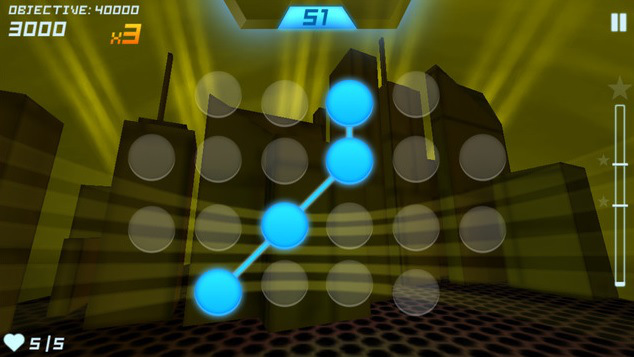Dave & Buster’s has done its share of saving the arcade game business in the U.S., where playing games for prizes is perhaps the last bastion of the big entertainment machines that many older Americans grew up with. By marrying prizes, food, and arcades, the Dallas-based chain of 76 locations has created a way to make money and provide fun for customers.
Now it is moving into mobile games with the announcement of three new mobile releases based on the classic arcade machines in the restaurants. The free-to-play mobile games are designed to be lasting fun titles, and they aren’t meant to publicize the restaurant chain. Rather, players can earn rewards in the mobile games that they can add to their Power Cards, which they can use to both play games and redeem prizes at Dave & Buster’s locations.
This marriage of digital mobile games and physical arcade locations is the brainchild of Kevin Bachus, the co-creator of the original Microsoft Xbox. Bachus joined Dave & Buster’s as its senior vice president of entertainment and games strategy in 2012, and he recently announced the new mobile titles: Speed of Light, Big Bass Wheel, and Tippin’ Bloks. We talked on the phone with him about the announcement.
Here’s an edited transcript of our interview.
GamesBeat: So you’ve been working on a mobile strategy for years at Dave & Buster’s?
Kevin Bachus: One of the first things the company ever talked about was, they wanted to understand how smartphones were affecting their customers. From the very first conversation, mobile was part of the discussion. It just took time to figure it out.
GamesBeat: You started in 2012, right?
Bachus: Right. We knew we wanted to do something outside of the store to stay connected with our guests. The company experimented with developing some original arcade-style games. There was discussion about publishing mobile games or something like that.
What I eventually realized was that the marketplace is so cluttered, and it’s so difficult for a mobile game to make an impact, that it would be foolhardy for us to try to be a legitimate mobile game publisher. It’s not our focus. Our focus is on running our locations.
I started to think about this as a way not of attracting new customers or expanding brand awareness, but rather a way to stay connected with existing guests. It all fell into place. I went out to the major game manufacturers we deal with, and I secured the rights to deal with what we call re-imaginations of
their original arcade games. Especially what we call redemption games, the ones that give you tickets that you redeem for prizes. They were surprisingly receptive. That led to these first three games.
GamesBeat: You don’t make any arcade games, right? You host games made by other companies.
Bachus: Believe it or not, despite the fact that people insist the arcade industry is dead, there’s actually vibrant and successful industry still creating coin-operated, swipe-card-operated games. We deal with about a dozen companies on a regular basis, and more of them less often. A number of them, particularly the ones based in the U.S., develop these redemption games.
When I first came to the company, I had this impression of arcades left over from growing up – racing games and light-gun shooters and space combat and that sort of stuff. But the vast majority of our amusements actually come from these redemption games. In the past they’ve been very simple games. They’re timing-based games where you press a button to stop a light and get the maximum points, or spin a wheel or something else. They’re all games of skill, but they’re fairly simple and quick.
Then there’s another category, the fastest-growing category of games, which combines these redemption qualities – the ability to win tickets – with additional entertainment value. We’ve seen a lot of app games translated into arcade games recently – Fruit Ninja, Infinity Blade, Temple Run. A bunch of games made that jump. Typically they’re built with much bigger screens and you can win tickets. There’s more of an entertainment component. They don’t typically do as well as original product, because—I suspect that most of our customers come for a unique experience. If they already have Candy Crush Saga – we just rolled out an arcade version of Candy Crush Saga – they may be more interested in something they can’t get elsewhere.
That was a very instructive experience for me. I didn’t want to make the same mistake in reverse. I didn’t just want to put a very simple arcade game on a cell phone. My guess is that it would grow tiresome very quickly. I wanted to go back to the drawing board and say, “What are the fundamental elements of these games that make them attractive?” If we were a mobile company and a designer came in with an idea for game with this big wheel that spins and you win prizes, what would it look like if it had never existed as an arcade game? That’s the design principle we’ve applied to these first three.
GamesBeat: Was the Power Card already in place as a loyalty system?
Bachus: I have to get you out to our San Jose store. You need to get up to speed on this. The way it works now, it’s like a Starbucks card. You go into Dave & Busters and you want to spend $20 on games. You go up to a kiosk or a server and you ask for a $20 Power Card. They give you the card with a certain amount of credit on it and you run around playing the games you want to play. Each game has a different price associated with it. You play until you exhaust the value on that card.
The new thing is, we just finished the largest infrastructure project we’ve ever done. We went out and changed out all the card swipes that we apply to the games, adding these brand new, gorgeous devices that are basically Linux-based touch screen computers. They activate the game, and they can also count your tickets. If you choose, you can select to have digital tickets instead of paper tickets. Instead of the thing spitting out tickets and you stand in line and the tickets get counted so you can choose your prizes, we apply them directly back onto the card you use to activate the game.
Down the road there’s a bunch of other stuff we’re going to do. We’ve built RFID into this thing. Because it’s Linux-based there’s an application layer. Right now the application is just credit for the game and counting the tickets, but it could do all sorts of things.
If you’ve been to a Dave & Busters, then, you have a Power Card. There’s a number on the back and a PIN number. You type it into the app and the tickets automatically go on your card. The next time you go in, if you have 1,000 tickets on your card and you play these games and win another 1,000, you come in and you’ve got 2,000 tickets.



